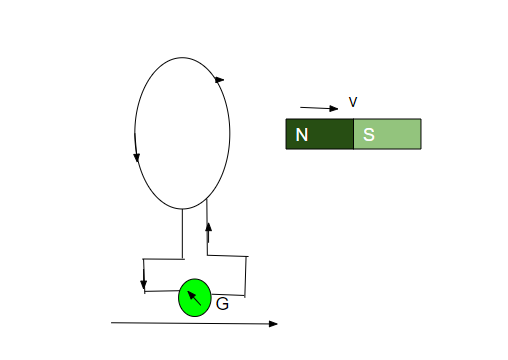楞次定律与能量守恒定律
在进入商场/电影院/机场/火车站时,您可能会面对一名手持金属探测器的保安进行安全检查。您可能还使用信用卡/借记卡通过将其刷入称为读卡器的机器来支付账单。你可能也见过交流发电机。所有这些都是根据楞次定律原理工作的。我们将在本文中讨论楞次定律。
Electromagnetic induction: It is the phenomenon of production of induced emf due to change of magnetic flux (number of magnetic field lines) connect to a close circuit is called electromagnetic induction.
什么是楞次定律?
Lenz states that the direction of induced current in a circuit is such that it opposes the change in magnetic flux. Lenz’s is named after the Jerman physicist “Emil Lenz “, who formulated it in 1834.
这是一个科学定律,它指定了感应电流的方向,但没有说明它的大小。连接到闭路的磁通量放大感应电流,使其产生与原始磁通量方向相反的磁通量。与闭合电路相连的磁通减少了沿原电流方向产生磁通的方向上的感应电流。
The Lenz’s Law formula is stated as,
E= -N(d∅/dt)
Here the negative sign indicates that the direction of induced emf is such that it opposes the change in magnetic flux).
插图 1:

如上图所示,当一个条形磁铁的北极向线圈移动时,线圈中的感应电流从磁铁侧看逆时针方向流动。线圈的表面形成北极。众所周知,同极相斥,所以北极-北极相斥。因此,它与磁铁北极的运动相反。
结论:磁铁的运动增加了通过线圈的磁通量,感应电流将产生相反方向的磁通量。
插图 2:

如图所示,当条形磁铁的北极离开线圈时,线圈中的感应电流顺时针方向流动。线圈的表面发展为南极。我们知道异极相吸。因此,北极和南极相互吸引。
结论:磁铁的运动减少了通过线圈的磁通量。感应电流在同一方向上产生磁通量,因此相反并增加磁通量。
楞次定律的重要用途是:
- 列车制动系统
- 交流发电机
- 平衡涡流
- 金属探测器
- 麦克风
- Eddy 的电流动态计
- 读卡器
楞次定律和能量守恒定律
楞次定律是能量守恒定律的结果。能量守恒定律指出,能量既不能被创造,也不能被消灭,但它可以从一种形式变为另一种形式。楞次定律指出,电流的方向与磁通量的变化相反。因此,需要额外的努力来对抗相反的力量。这种额外的工作会导致磁通量的周期性变化,因此会感应出更多的电流。因此,额外的努力只转化为电能,这不过是能量守恒定律。
磁通量随着磁铁的北极接近它而增加,并随着它在上面的活动中被驱离而下降。在第一种情况下,相反的原因涉及移动磁铁,面向线圈的面获得北极。磁铁的北极和线圈的北极相互排斥。为了抵消排斥力,必须进行机械动作以使磁铁朝向线圈。这种机械能转化为电能。由于焦耳效应,这种电能转化为热能。
当磁铁从线圈移开时,线圈较近的一面获得南极。在这种情况下,产生的电动势将与磁铁的向外运动相反。为了抵抗磁铁北极和线圈南极之间的吸引力,必须再次进行机械劳动。这种劳动转化为电能。
如果磁铁不移动,则不会做任何机械功,因此线圈中不会感应出电动势。
因此,楞次定律与能量守恒定律是一致的。
法拉第电磁感应定律:
First law: It states that whenever the magnetic flux is linked with a closed-circuit change, an emf is induced in it which lasts only as long as the change in flux is taking place. If the circuit is closed then current also gets induced inside the circuit which is called ” Induced current”.
磁场可以通过以下方式改变:
- 将条形磁铁移向或远离线圈。
- 将线圈移入磁场或移出磁场。
- 使线圈相对于磁铁旋转。
- 改变放置在磁场中的线圈的面积。
Second law: It states that the magnitude of the induced emf is equal to the rate of change of magnetic flux linked with the closed circuit.
|∈| = dⲫ/dt
E = -N dⲫ/dt
E = -N (ⲫ2-ⲫ1)/t ⇢ (“t”是时间)
示例问题
问题 1:楞次定律的结果是什么?
回答:
Lenz’s law is a consequence of the law of conservation of energy.
问题2:如果颠倒楞次定律会发生什么?
回答:
The induced current would produce a flux in the same direction at the original change.
问题 3:楞次定律在现实生活中是如何应用的?
回答:
Lenz’s law is used in electromagnetic brakes in trains. It is also applied in electric generator, AC generator.
问题 4:闭环通常在大电容器极板之间的静电场中移动。当该电容器完全位于极板之间的区域内时,产生的电流量是多少?
回答:
Current cannot be induced by changing electric flux. So, no current is produced when it is wholly inside the region between the capacitor plate.
问题5:法拉第定律和楞次定律的区别?
回答:
Lenz’s law states the direction of an induced current.
Faraday’s law states that the magnitude of the emf induced in a circuit is proportional to the rate of change of magnetic flux.
问题 6:在确定交流发电机中的电流方向时使用了哪条定律?
回答:
Lenz’s law is used in finding the direction of current in an AC generator.
问题 7:用什么定律来确定涡流的方向?
回答:
As we know that Eddy current also oppose the change in magnetic flux, so the direction is given by Lenz’s law.